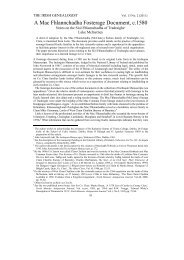Report Cover Vol I - Clare County Library
Report Cover Vol I - Clare County Library
Report Cover Vol I - Clare County Library
You also want an ePaper? Increase the reach of your titles
YUMPU automatically turns print PDFs into web optimized ePapers that Google loves.
The <strong>County</strong> <strong>Clare</strong> Wetlands Survey Patrick Crushell & Peter Foss 2008<br />
___________________________________________________________<br />
Wet willow-alderash<br />
woodland<br />
Includes woodlands of<br />
permanently waterlogged<br />
sites that are dominated by<br />
willows (Salix spp.), Alder<br />
(Alnus glutinosa) or Ash<br />
(Fraxinus excelsior), or by<br />
various combinations of<br />
some or all of these trees.<br />
It includes woodlands of<br />
lake shores, stagnant<br />
waters and fens, known as<br />
carr, in addition to<br />
woodlands of spring-fed or<br />
flushed sites. Carr occurs<br />
on organic soils and fen<br />
peats that are subject to<br />
seasonal flooding but<br />
remain waterlogged even<br />
when flood waters recede.<br />
As the area of fen has declined<br />
so has the area of<br />
wet woodland, mostly as a<br />
result of activities such as<br />
peat cutting and mining,<br />
conifer afforestation, agricultural drainage and reclamation, infilling, and fertiliser pollution from adjacent farmland.<br />
Although drainage of fens may in some cases have led to a local short term increase in the cover of wet<br />
woodland in some areas.<br />
Likely to be the most common wet woodland type in <strong>County</strong> <strong>Clare</strong>, examples of the habitat can be seen within<br />
Dromore Woods and Loughs SAC.<br />
Bog woodland<br />
Priority habitat under the<br />
EU Habitats Directive.<br />
Woodlands found on intact<br />
ombrotrophic bogs (raised or<br />
blanket), bog margins and<br />
cutover bog. Bog woodland<br />
typically occurs on deep acid<br />
peat that is relatively<br />
well-drained in the upper<br />
layers and is commonly<br />
associated with former turf<br />
cutting activity or drainage<br />
or where internal raised bog<br />
drainage patterns allow the<br />
development of woodland<br />
stands (i.e. soak systems on<br />
bogs). It may also occur in<br />
areas of cutover bog where<br />
most of the peat has been<br />
removed. Downy Birch<br />
(Betula pubescens) is the<br />
usual dominant and may<br />
form pure stands. Willows (Salix spp.) may also occur.<br />
A characteristic feature is the ground cover of Sphagnum moss species which often form deep carpets, usually<br />
with Polytrichum mosses and occasional Lichens.<br />
Woodland of waterlogged acid peats in hollows or depressions in areas of upland woodland on siliceous rocks may<br />
also be included in this habitat category.<br />
Bog woodlands are closely associated with raised bogs, occurring either on intact bogs, on cutaway or on<br />
transition mires (transition between fen and bog). They are found mostly in the central and north midlands.<br />
Their total area is uncertain.<br />
They are threatened by drainage, peat cutting, burning and development; although in the long term it is believed<br />
that they will expand as cutaway re-floods.<br />
A relatively rare habitat in <strong>Clare</strong>, an example has been reported from Loughanilloon Bog Bog NHA.<br />
34
















